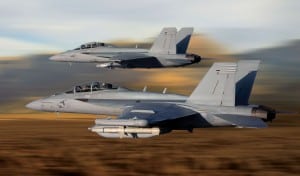The U.S. Defense Department and Australian Department of Defense expanded their cooperative partnership on the Next Generation Jammer by signing a project arrangement on future variants.
In the July 13 agreement, the countries signed a Next Generation Jammer Low Band (NGJ-LB) Project Arrangement (PA) “to ensure commonality on future jamming variants.”

The Navy underscored the NJG cooperative work aims to share both costs and risks in the program while both gain improved jammer capabilities in aircraft.
The NGJ is how Naval Air Systems Command plans to augment and replace the legacy ALQ-99 tactical jammer system on EA-18G Growlers, splitting it up into low-, mid- and high-band frequency increments. Aircraft will use these jammers to help counter and defeat enemy air defenses and communications systems,
In 2017, the Australian Defense Minister, at the time Marise Payne, said Australia entered into an agreement with the U.S. Navy to jointly develop the NGJ for the Growlers.
The Navy’s announcement said the newly expanded partnership will allow commonality between the countries, which both operate Growlers.
According to an Australian Department of Defense project description webpage, the government estimates the effort to upgrade their Growlers will have them in service by 2024, initial operational capability in 2025, and final operational capability in 2031.
“This expanded partnership with Australia to develop the newest Airborne Electronic Attack (AEA) jamming capability shows the level of commitment of both countries to ensure continued superiority of the electromagnetic spectrum,” U.S. Navy Capt. Michael Orr, AEA Systems program manager (PMA-234), who oversees all NGJ programs, said in a statement.
“The NGJ-LB PA allows for joint sharing of the best technologies in the world, furthering the AEA capabilities of both the U.S. Navy and the Royal Australian Air Force (RAAF),” he continued.
“Our processes are further enhanced by international partnerships like this one. I commend everyone involved in making this happen for their great work so that together we can reduce costs and increase capabilities for our partners and our Navy,” Rear Adm. Shane Gahagan, Program Executive Officer for Tactical Aircraft Programs, added.
NAVAIR clarified that currently the NGJ-LB program is in the material solutions analysis phase, executing two demonstration of existing technologies contracts with L3Harris Technologies [LHX] and Northrop Grumman [NOC].
NAVAIR awarded both companies contracts worth over $35 million each to demonstrate and test technologies for the NGJ-LB in 2018 after the Government Accountability Office denied a protest by Raytheon Technologies [RTX] (Defense Daily, Oct. 26, 2018).
In May, the Navy said it had started the final set of a 20-month long demonstration of existing technologies tests for NGJ-LB (Defense Daily, May 20).
In fall 2020 the Navy plans for the program to enter the next phase of acquisition when it awards the Capability Block 1 contract.
Relatedly, the Navy announced the U.S. and Australia also signed a second memorandum of agreement in May to enter production, sustainment and follow-on development for the AN/ALQ-249 NJG-Mid-Band (MB) and follow-on variants.
Orr commented in a statement that “having a cooperative sustainment strategy will increase military effectiveness at home and abroad, strengthen technology capabilities, and reduce a duplication of effort across nations.”
In 2016, the Navy awarded Raytheon a $1 billion contract for the design, manufacture, demonstration, and testing of the NGJ-MB program (Defense Daily, April 15, 2016).
The Navy noted the NGJ-MB program is currently in the Engineering and and Manufacturing Development stage and will start developmental flight testing on EA-18Gs this summer. The program expects to finish Milestone C in the fall, followed by a low -rate initial production contract.